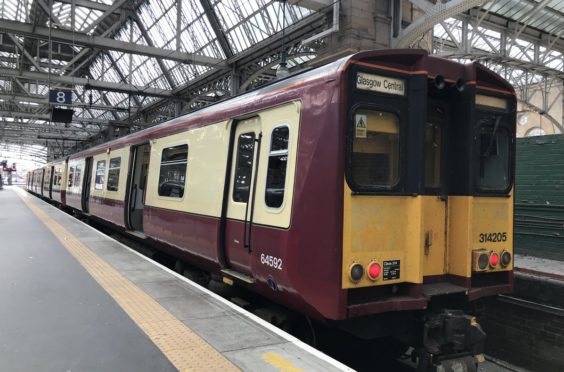
Passengers on one of Scotland’s busiest commuter lines are still stuck with old trains from the 1970s more than a year after ScotRail said they’d be phased out.
The rail operator introduced the class 314s – built 40 years ago in York – as a stopgap in Inverclyde while new trains were diverted elsewhere for driver training.
ScotRail said at the beginning of 2017 that it hoped to have an all-modern fleet of trains on the line by May the following year.
But more than a year on, the old 314s are still run on the Inverclyde line, which travels through Greenock and Paisley into the country’s busiest station, Glasgow Central.
Some are also run on the Cathcart circle in Glasgow’s south side.
Next month marks exactly 40 years since the 314s were introduced in Scotland. Politicians said continued use of the old trains was “inexcusable”.
One Inverclyde passenger, who did not wish to be named, said last week: “When your train arrives and it’s one of the old ones you just feel like groaning.
“They are well past it and people feel it’s not fair that other lines have modern trains and the people in Gourock, Greenock or Paisley get stuck with these old ones without any fare discounts.”
The old models have been criticised over reliability and for having no toilets, poor heating and a lack of facilities such as wifi and chargers.
ScotRail have been describing use of the 314s on the line as a “temporary measure” for years.
A rail source said: “Class 314s are used on Inverclyde and Cathcart Circle and full withdrawal still depends on the final delivery of the Class 385s which will continue to be delivered throughout the year.”
The ScotRail franchise has been run by Abellio, a subsidiary of Dutch state rail firm NS, since April 2015.
Performance levels have regularly dipped since then below the point at which Abellio risked being stripped of its £7 billion, 10-year contract.
Scottish Conservative transport spokesman Jamie Greene said: “There can’t be many modern countries in the world where trains four decades old are depending on for taking people to work in the biggest city.
“It’s completely unfair for commuters to pay 21st century prices on 1970s trains.”
A ScotRail spokesman said: “The majority of services between Glasgow and Inverclyde are operated by modern Class 380 trains.
“The use of Class 314 trains on this route will continue to be reduced as we withdraw them from the ScotRail network.”

Enjoy the convenience of having The Sunday Post delivered as a digital ePaper straight to your smartphone, tablet or computer.
Subscribe for only £5.49 a month and enjoy all the benefits of the printed paper as a digital replica.
Subscribe